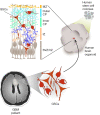New approaches to model glioblastoma in vitro using brain organoids: implications for precision oncology
- PMID: 35117142
- PMCID: PMC8798484
- DOI: 10.21037/tcr.2019.09.08
New approaches to model glioblastoma in vitro using brain organoids: implications for precision oncology
Conflict of interest statement
Conflicts of Interest: All authors have completed the ICMJE uniform disclosure form (available at http://dx.doi.org/10.21037/tcr.2019.09.08). The authors have no conflicts of interest to declare.
Figures

Comment on
-
Modeling Patient-Derived Glioblastoma with Cerebral Organoids.Cell Rep. 2019 Mar 19;26(12):3203-3211.e5. doi: 10.1016/j.celrep.2019.02.063. Cell Rep. 2019. PMID: 30893594 Free PMC article.
References
Publication types
LinkOut - more resources
Full Text Sources
